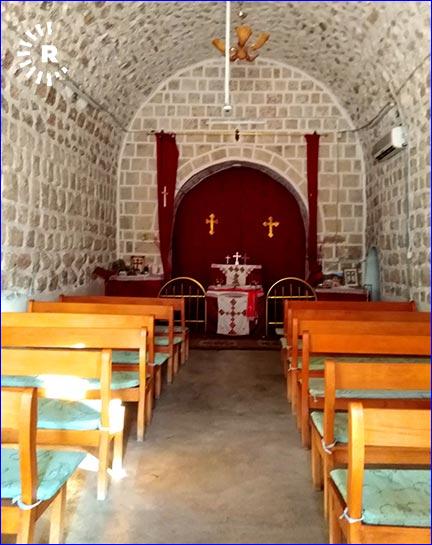


 Rudaw)
Rudaw)
Father Elias Daud, born in Dere in 1935 but raised in Baghdad, returned to the village in 1973. He's been leading services and taking care of the monastery for the past 30 years.
"The monastery was destroyed twice, once in 1963 and a second time in 1987 by Saddam Hussein," Fr. Elias told Rudaw English.
It was rebuilt by the people and remains at the heart of Kurdistan's Assyrian faithful.
"The government didn't give us money to rebuild it, so we relied on donations from the community to rebuild both times, using pieces of the original building," he said.
Fr. Elias says that people of different faiths and ethnicities come from all around the Kurdistan Region and Iraq to visit.
"Here there are no different cultures," he said. "We have one culture. It doesn't matter if you are Kurdish, Yezidi, Muslim, or Christian."
People of other faiths come to Mar Odisho to pray, especially infertile women hoping to become pregnant.

 Rudaw)
Rudaw)
Snow and winding roads leading up the mountain make it hard to reach the monastery during the winter months, so it's mostly just local villagers attending church services. But when the snow melts, hundreds of believers come to worship and celebrate Assyrian holy days.
The largest annual event is the day of Saint Odisho himself, which attracts anywhere from 1,000 -- 2,000 people.
Many Assyrian churches worldwide are named after the saint, who is known as Abdisho bar Berika or Ebedjesu in classic Syriac language.

 Rudaw)
Rudaw)
Odisho was born in modern day Mardin in Turkey and later became the first Assyrian bishop in what is now known as Shingal.
A scholar, Mar Odisho is credited for writing Marganitha, one of the most important ecclesiastical texts of the Assyrian Church of the East as well as poetry and legal texts.
November 2018 marked 700 years since his death. He is believed to have been murdered under the orders of Shapur II the Great, the longest-reigning monarch in Persian history, known for persecuting Christians.
Fr. Elias said that busloads of people come to commemorate the death of the saint. They spend the day in prayer and then sacrifice some 70 sheep for a grand feast in the evening.
With 2018 coming to an end, Fr. Elias is optimistic that 2019 will bring joy to the local and international community.
"I hope that Iraq will be good and that all people around the world will be happy in the New Year," he said.

or register to post a comment.